Introduction
In the digital era, data is a key part of organizational strategy, shaping decisions, driving innovation, and forging new frontiers of competitive advantage. Data not only powers the engines of innovation but also anchors the operational excellence of organizations. This approach, deeply rooted in ensuring data quality and trust, has been instrumental in maintaining integrity, compliance, and efficiency for daily operations. Organizations have primarily focused on data defense, emphasizing the secure storage, meticulous governance, and stringent compliance of their data assets. This is driven by the need to navigate the regulatory landscapes and protect the organization from data breaches and losses. The proliferation and advancements in data analytics, AI, and machine learning provide unprecedented opportunities to harness data for strategic advantage. Businesses are now recognizing the untapped potential of their vast data reservoirs and the competitive edge they can gain by shifting towards a more offensive data strategy. This shift not only involves adopting new technologies but also entails a cultural and mindset change where data is viewed as a strategic asset, driving growth, innovation, and sustained competitive advantage.
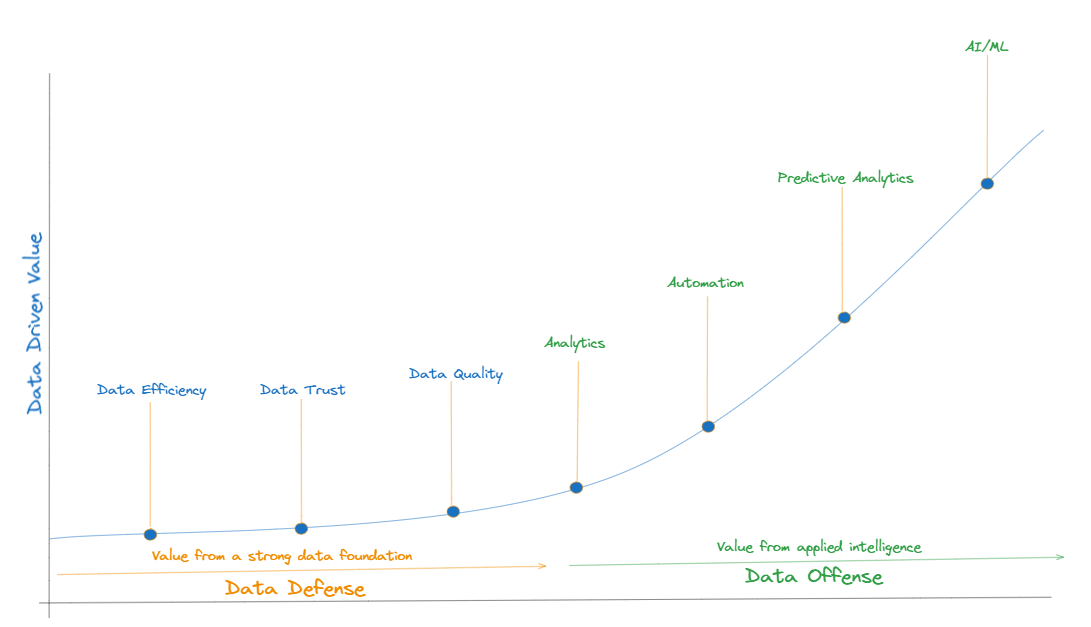
Data defense is about protecting the organization’s data assets, maintaining regulatory compliance, and managing risks. It focuses on ensuring the security, quality, and governance of data. Data offense, on the other hand, focuses on leveraging data to drive business growth, innovation, and competitive advantage. It’s about extracting value from data, making informed decisions, and enhancing customer experiences. Understanding the differences between these strategies can help organizations balance their approach and harness the full potential of their data assets. Data mesh architectures enable organizations to move up this continuum of data transformation from defensive to offensive capabilities to empower them to use data strategically. DataMesh empowers organizations to turn their data landscape into a platform enabling self-serve data products, fostering decentralization, scalability, and agility in data intelligence. To understand more about data mesh architectures, lets look at the evolution of data architectures and the forces that have influenced this evolution. Organizations generally start with a monolithic data architecture. The monolithic data architecture is characterized by a centralized approach to data storage, processing and analytical capabilities. As organizations grow, monolithic architecture often fall short. Monolithic architectures often struggle with scalability. As data volumes and processing needs grow, these systems can become overloaded, leading to performance bottlenecks. As organizations start to feel this pain they generally evolve to hybrid data architectures. Hybrid data architectures is the most architectures across many organizations.
Monolithic Data Architectures
Monolithic data architectures are characterized by their centralized and unified structure. These architectures were the foundational framework for data management in many enterprises, especially before the advent of distributed computing and cloud technologies. In a monolithic architecture, all data management processes, including collection, storage, processing, and analysis, are centralized in a single system or platform. The unified nature of monolithic architectures ensures consistency and integrity of data. It generally operates on a single data model or schema which provides a consistent view of the data. It simplifies management and operations, as there are fewer moving parts and a single system to monitor and maintain. However, this centralization can create bottlenecks as the system scales. As data volumes and processing demands grow, monolithic architectures often struggle to scale efficiently. Scaling usually requires scaling the entire system, which can be expensive and complex. Components in a monolithic architecture, such as the database, application code, and user interface, are closely interlinked. This tight coupling can simplify development and deployment initially but makes the system more rigid and difficult to modify or scale. The tightly coupled nature of components in a monolithic architecture makes it challenging to adapt to changing business needs, incorporate new technologies, or alter data processing workflows. The centralized nature of monolithic architectures implies that a failure in one component can potentially impact the entire system, posing significant risks to data availability and business continuity.
To overcome these challenges organizations sought more adaptable, scalable, and resilient solutions to manage their expanding data needs. This quest has led to the evolution of hybrid data architectures.
Hybrid Data Architectures
Hybrid data architectures dismantle the monolithic model, distributing data management tasks across specialized, interconnected planes. This architecture provides a sophisticated blend of transactional data planes, data pipelines, and analytical data planes. This style reflects a holistic approach to data, recognizing the distinct needs of transactional processing, data transformation and movement, and in-depth analytics.

The operational data plane is responsible for handling the day-to-day operations of the business. It includes systems that support business processes, such as transaction processing systems, CRMs, ERPs, and other operational databases. This layer handles transactions and operations in real-time, ensuring immediate consistency and availability. This layer is optimized for OLTP (Online Transaction Processing) workloads, focusing on efficiently handling large numbers of transactions. As this layer deals with transactional data, it maintains strict data integrity rules and transactional consistency, often using ACID (Atomicity, Consistency, Isolation, Durability) properties.
Data pipelines are the conduits through which data flows from operational systems to analytical systems. They are responsible for extracting, transforming, and loading (ETL) data into a suitable format for analysis. The pipelines extract data from various operational data sources. This data is then cleaned, normalized, enriched, and transformed into a format suitable for analysis. This process might involve data deduplication, validation, and format standardization. The transformed data is then loaded into the analytical data plane’s storage system. The extraction, transformation and loading of data is a resource intensive process. Data pipelines are often orchestrated and scheduled to run at specific intervals, ensuring optimum resource utilization and data freshness in the analytical systems.
The analytical data plane is optimized for data analysis and decision-making. It stores processed data from operational systems and is designed to handle complex queries and large-scale analytics. The analytical data plane includes components such as data warehouses/data lakes, data marts, analytical tools, Dashboards, reports and many others. Data warehouses and Data lakes are storage solutions optimized for querying and analyzing large datasets. Data warehouses provide structured data optimized for SQL queries, while data lakes offer raw, unstructured data suitable for big data processing. Tools such as Hadoop, Spark, or Flink are used for processing large volumes of data in parallel, handling complex analytical tasks or machine learning workloads. Business intelligence (BI) tools, reporting tools, and dashboards are used to visualize, report, and derive insights from data stored in date warehouses and data lakes.
This architecture is powerful and offers numerous benefits. This architecture separates the concerns of operational processing and analytical processing, allowing each layer to be optimized for its specific use case. The operational data plane ensures high performance and data integrity for business operations, while the analytical data plane provides the necessary infrastructure for deep analysis, insights, and decision support. Data pipelines play a crucial role in ensuring that the data flows smoothly between these planes, maintaining data quality and freshness.
However, this architecture also comes with its own set of challenges and drawbacks. The ETL process in data pipelines can introduce latency. The time it takes to extract, transform, and load data can lead to delays in data availability in the analytical plane. Real-time or near-real-time analytics requirements can be hard to meet due to these inherent latencies. Ensuring data consistency across operational and analytical systems can be challenging. Data quality can be compromised during the transformation process if not handled meticulously, leading to unreliable insights and decisions. Integrating various data sources and systems can be complex and often requires significant effort in terms of middleware or custom integration development. As data volumes grow, scaling the data pipelines and storage efficiently while maintaining performance can become a significant challenge. This architecture requires upfront design to handle scalability, which can be complex and expensive.
Data Mesh
Data Mesh architecture is a modern approach to data engineering and data operations that aims to improve the scalability, agility, and innovation of data teams within an organization. It promotes a more decentralized, domain-oriented, and collaborative approach to data engineering, enabling organizations to scale, adapt, democratize, and govern their data effectively. It’s a socio-technical approach that emphasizes decentralization of data ownership and architecture. This shift enables organizations to transition from a defensive approach to an offensive strategy, aimed at leveraging data for growth, innovation, and competitive advantage.
In a Data Mesh architecture, data ownership is distributed among domain-oriented teams who are responsible for the data within their respective domains. These domain teams operate with a product mindset, treating data as a product and using product management practices to define data product roadmaps, iterate on data products, and align them with business needs. The concept of domain-oriented teams in data mesh architecture is based on the idea that data expertise should be distributed across the organization, rather than being concentrated in a central data team. By empowering domain-oriented teams with data ownership and autonomy, organizations can enable faster decision-making, agility, and innovation in their data operations. These teams have access to self-serve data infrastructure, which provides standardized data tools, services, and APIs allowing them to create, manage, and operate their data pipelines, data stores, and data products independently. This promotes agility and reduces dependence on centralized data engineering teams.
By adopting a Data Mesh approach, organizations aim to overcome the limitations of traditional centralized data engineering practices, such as data silos, lack of ownership, scalability and agility challenges.
Principles of Data Mesh Architecture
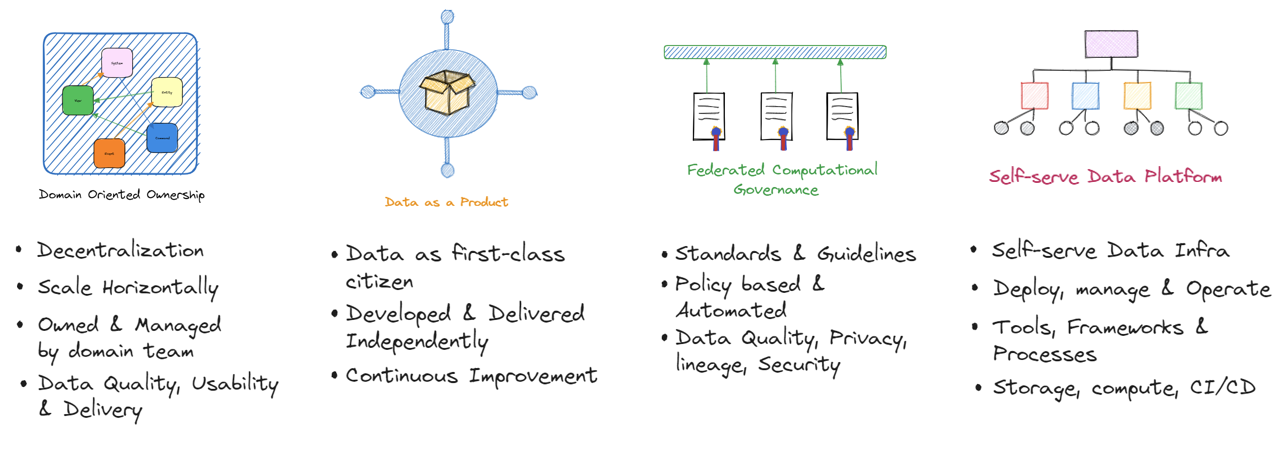
Data Mesh architecture is based on a set of key principles that provide a foundation for its design and implementation. These principles are:
Domain-oriented ownership: Data is owned by domain-oriented teams who are responsible for the data within their respective domains. This promotes data autonomy and accountability, allowing domain teams to make decisions on data models, data pipelines, and data products that are aligned with their specific domain needs. These teams are responsible for data architecture for the respective domains
Data as a Product (DaaP): Data is treated as a product, and data teams operate with a product mindset. This includes applying product management practices such as understanding customer needs, defining data product roadmaps, and iterating on data products based on feedback and data-driven insights.
Self-serve data infrastructure: Data teams have access to self-serve data infrastructure that allows them to create, manage, and operate their data pipelines, data stores, and data products independently. This promotes agility and reduces dependence on centralized data engineering teams for day-to-day data operations.
Federated data governance: This principle refers to the distributed and collaborative approach to data governance across domain-oriented teams in a data mesh architecture. In a data mesh, each domain-oriented team is responsible for the data products and services within their domain, including data ingestion, data storage, data processing, and data serving. This decentralized approach allows domain-oriented teams to have ownership and autonomy over their data assets and enables them to iterate and innovate faster.
These principles lay emphasis on
Data as a first-class citizen: Data is treated as a first-class citizen in the organization, with proper governance, quality, and security measures in place. This includes establishing data standards, data lineage, data quality checks, and data security protocols to ensure data integrity and compliance.
Platform thinking: Data infrastructure is treated as a platform that provides standardized data tools, services, and APIs that can be leveraged by domain teams to build and operate their data products. This promotes consistency, reusability, and scalability across different domains.
Democratized data access: Data is democratized and made accessible to various stakeholders across the organization. This includes providing self-service data access tools and technologies that empower business users, data scientists, and other stakeholders to access and analyze data without relying on data teams for every data request.
Culture of collaboration: Data teams collaborate closely with domain teams, business stakeholders, and other data teams to ensure alignment, knowledge sharing, and cross-domain learning. This promotes a culture of collaboration, innovation, and continuous improvement in the organization.
These key principles of Data Mesh architecture emphasize domain-centric ownership, product thinking, self-serve data infrastructure, platform thinking, data governance, democratized data access, and a culture of collaboration. By adhering to these principles, organizations can unlock the benefits of Data Mesh architecture and enable data-driven agility and innovation in their data operations. The concept of distributed ownership of data products also ensures that each domain is responsible for all aspects of the data lifecycle such as ingestion, mapping lineage, quality, consolidation etc. Applying these principles in an iterative approach across the domains listed above would result in an architectural evolution to data mesh similar to the below.
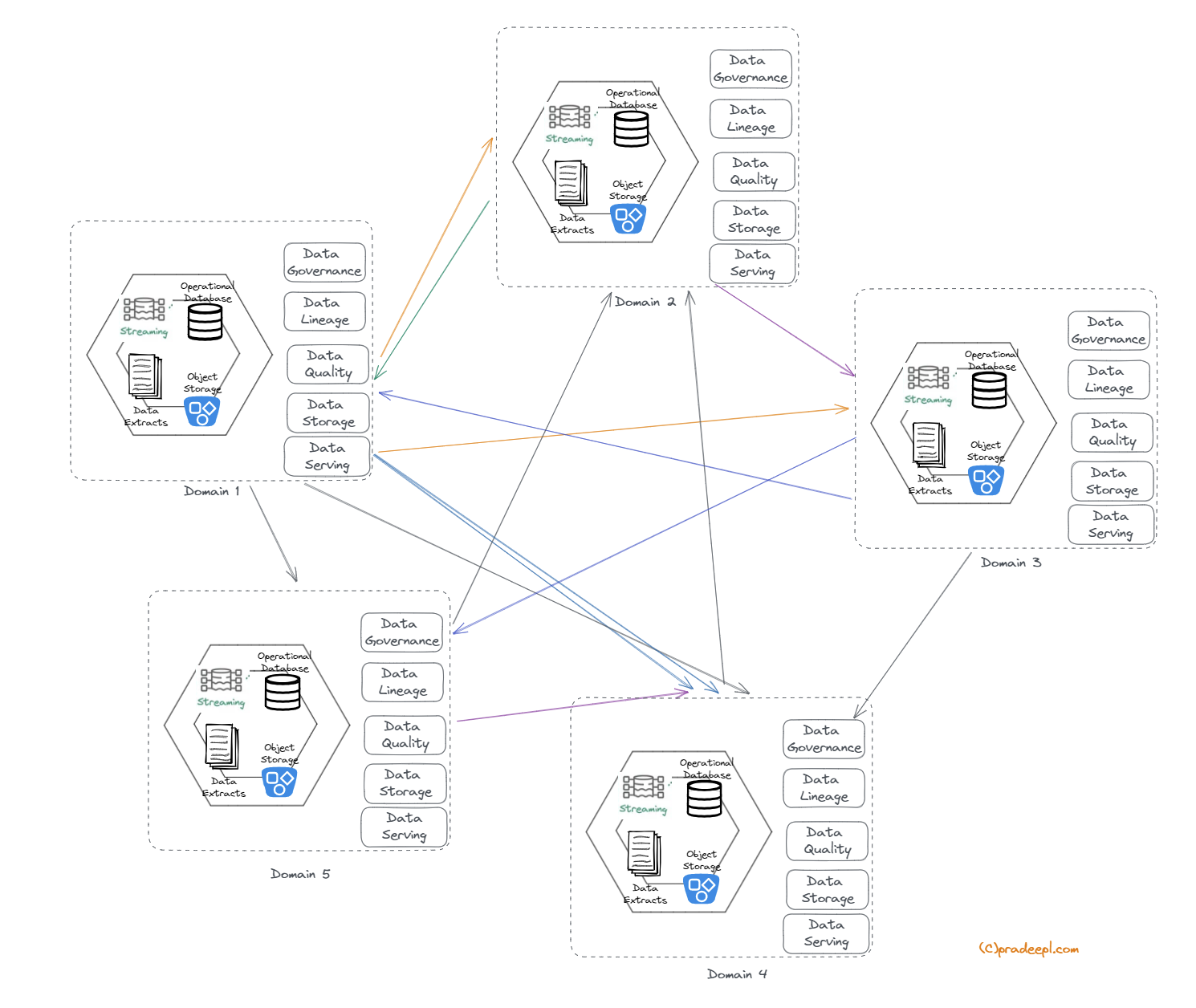
This empowers teams to define and manage the lifecycle of the data product.
Key concepts of Data Mesh Architecture
Domain Team
In a data mesh architecture, a domain team is structured around a specific business domain or capability. This team is responsible for the data within their domain, including the data pipelines, storage, and serving layers. The team consists of cross-functional members, including data engineers, data scientists, domain experts, and product owners.The domain team has the autonomy to make decisions about the data within their domain, including data quality, data formats, and data contracts. They work closely with other domain teams and the data platform team to ensure that their data is discoverable and accessible to the broader organization. This team is responsible for the architecture and design of the data domain. They may choose to use different architectural patterns such as Lambda architecture , Kappa architecture and others.This team is responsible for defining and maintaining the data products that are specific to their domain. These data products are used by other teams within the organization to build applications and make data-driven decisions. The domain team is responsible for ensuring that the data products meet the needs of the organization and that they are aligned with the broader data mesh architecture principles. This fosters a data product thinking mindset within domain-oriented teams, treating data as a valuable product that can be used to drive business outcomes.
Data Product
A data product is an architectural quantum. It is a self-contained unit that encapsulates all the components needed to deliver value to its users, domain experts, or stakeholders. It is a self-contained, self-descriptive unit of data that has intrinsic value. It includes not just the raw data, but also the metadata, documentation, and the tools necessary to use it effectively. This makes the data product independently understandable and usable without requiring extensive external context or support. It is an independently deployable component with high functional cohesion. It includes all structural elements needed to function completely. Data products are organized around specific business domains, ensuring that the data is relevant, coherent, and aligned with domain-specific needs. This domain-oriented approach ensures that the data product is deeply integrated with the business context, making it more valuable and actionable. The data product is owned and managed by a cross-functional domain team that typically includes data engineers, data scientists, domain experts, and product managers. This team is responsible for the entire lifecycle of the data product, from creation and maintenance to updates and retirement. This team ensures that the data product is accurate, up-to-date, and compliant with relevant standards and regulations. Data products are designed to be easily discoverable and accessible within the organization. They are cataloged in a way that allows potential consumers to find them, understand their purpose and contents, and know how to access and use them effectively.
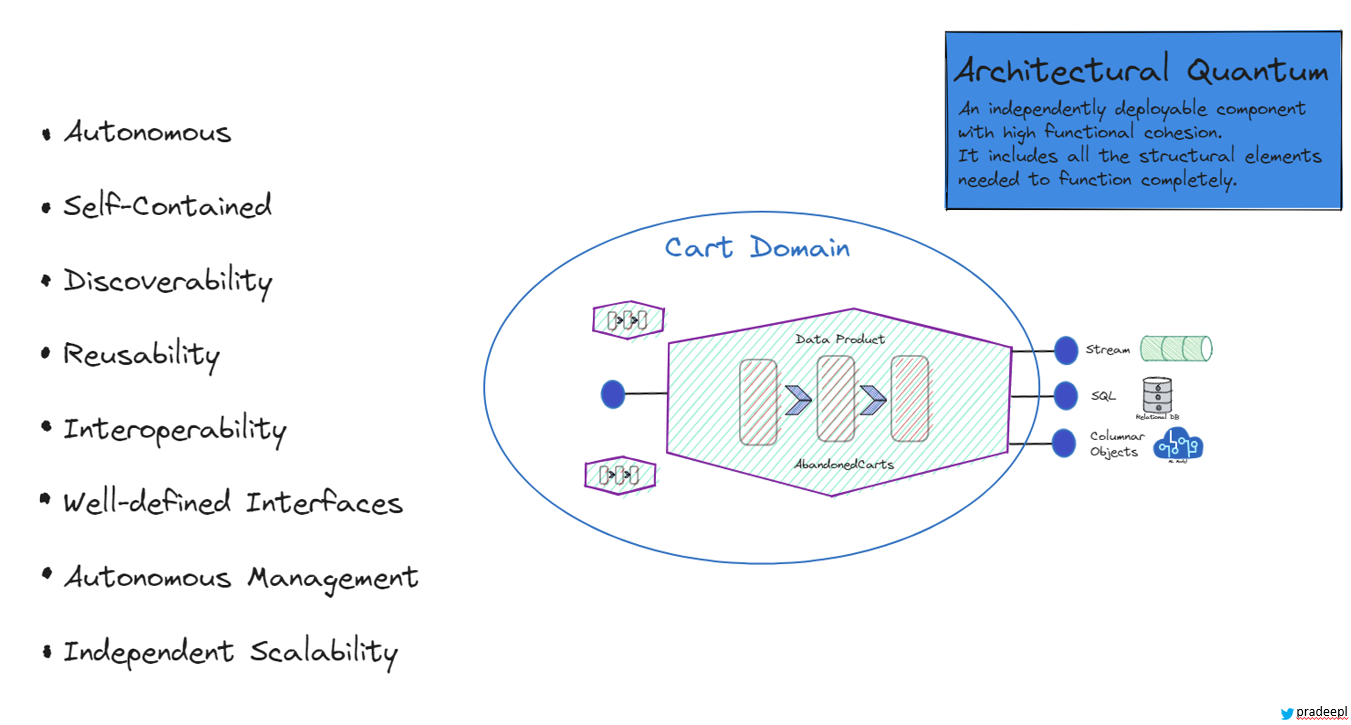
A data product is
- Autonomous – It is independent in terms of its deployment, scaling, maintenance, and lifecycle management.
- Self-Contained: It includes all the necessary elements for its function, including data, metadata, documentation, transformation logic, access mechanisms, and quality metrics.
- Discoverability: Data Products are discoverable by users within the organization. It’s easy to find, access, and understand its purpose and content.
- Reusability: Data Products can be reused across the organization. Other teams can build upon or extend existing quanta to create new Data Products.
- Interoperability: Despite their independence, Data Products are designed to interoperate and work together within the data mesh architecture.
- Well-Defined Interfaces: Each Data Product exposes well-defined interfaces, such as APIs or access points, that allow users to interact with its data and functionalities.
- Autonomous Management: Teams responsible for a Data Product have control over its development, deployment, scaling, and operation. They manage it independently.
- Scalability: Each Data Product can be scaled independently based on its specific usage patterns and demands.
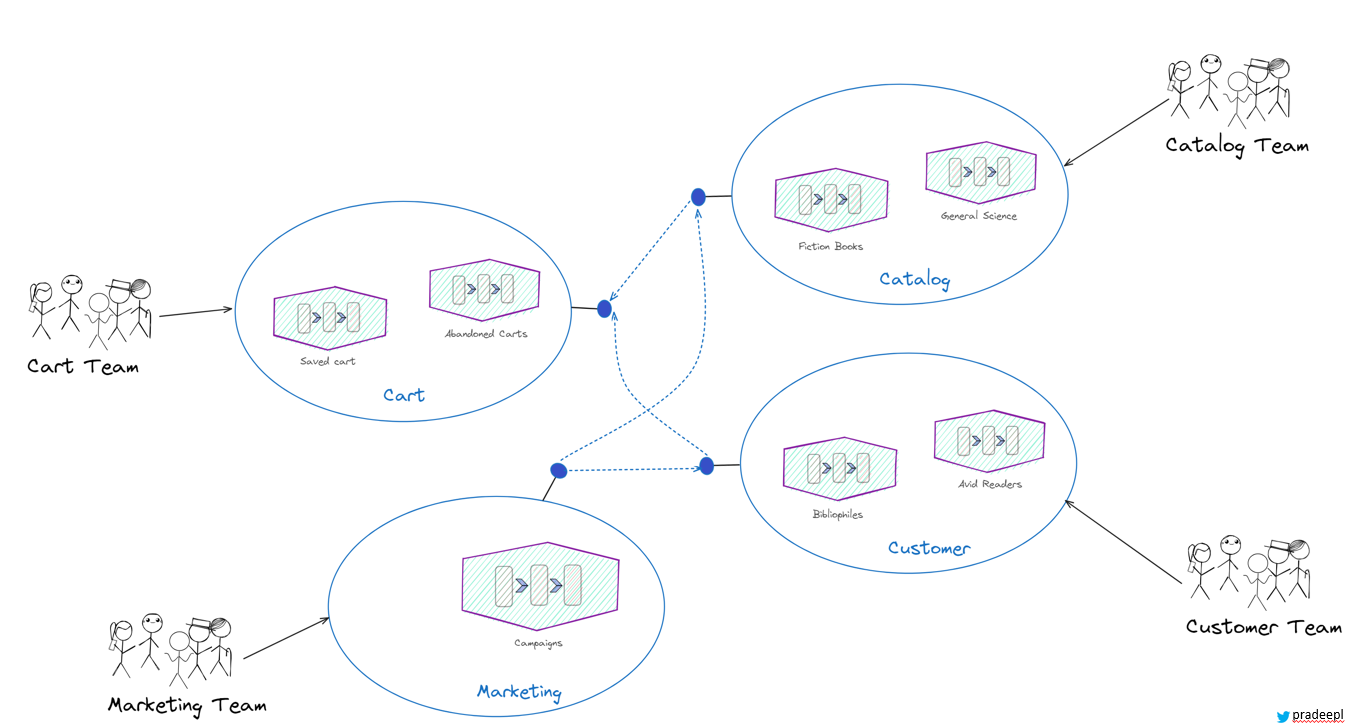 Data Mesh Architecture
Data Mesh Architecture
Challenges of implementing a Data mesh architecture
Implementing Data Mesh in an organization can be challenging due to its comprehensive and transformative nature. Data Mesh is not just a technological shift but also a fundamental change in the organizational approach to data management, culture, and processes. The primary challenge in implementing a data mesh architecture is the cultural shift required within an organization. For a a lot of organizations this means shifting from a centralized to a decentralized data ownership model. Data mesh promotes a shift towards domain-oriented teams, where data ownership and responsibilities are distributed across different teams. This can require changes to the organization’s culture, structure, and mindset, including fostering a culture of collaboration, empowerment, and accountability.
Data mesh architecture prioritizes domain-oriented teams. These are cross functional teams with a mix of skills in data engineering, data modeling, data governance, data science, domain expertise, and product management among others. Building such diverse cross-functional teams can be challenging. Organizations may need to invest in the right tools, training and hiring talent with the right skill set required to support a data mesh architecture.
Traditional data teams are used to project-based work. Shifting the mindset to treating data as a product, with continuous development, maintenance, and customer-centric thinking, can be a significant change. Establishing clear ownership and accountability for data products in a decentralized model can be complex, especially in large organizations with numerous domains. Distributing data ownership and responsibilities across domain-oriented teams in a data mesh architecture can present challenges in maintaining consistent data governance and security practices. Ensuring data consistency, data quality, data privacy, and data security can require robust governance processes, data standards, and data policies across different domains, teams, and technologies. Implementing a data mesh architecture involves significant changes in the organization’s data engineering practices, team structure, and data ownership. Change management can be challenging, and organizations need to carefully plan and manage the change process, including stakeholder engagement, communication, and training, to ensure successful adoption of data mesh architecture.
Implementing a data mesh architecture can introduce complexity and scalability challenges. With multiple domain-oriented teams working independently, managing and scaling the data platform, data infrastructure, and data processing pipelines can become complex. As the number of data products grows, ensuring that the data mesh scales efficiently without becoming unwieldy or excessively complex requires careful planning and management. Organizations need to carefully plan for scalability, performance, and complexity management to ensure smooth operations of the data mesh architecture.
Data mesh architecture emphasizes the use of self-serve data infrastructure and tooling by domain-oriented teams. Organizations may need to evaluate, select, and implement appropriate data tools and technologies that align with the principles of data mesh architecture. This can involve challenges in tooling standardization, integration, and maintenance.
These are some of the challenges that organizations may face when implementing a data mesh architecture. However, with proper planning, governance, collaboration, and change management, these challenges can be overcome, and organizations can reap the benefits of a data mesh architecture in terms of improved data agility, scalability, and innovation.
Conclusion
In conclusion, data mesh architecture is a modern approach to data engineering that addresses some of the challenges of traditional data architectures. It emphasizes the principles of domain-oriented teams, self-serve data infrastructure, and data product thinking to enable organizations to scale data capabilities, improve data agility, and foster a culture of data ownership and collaboration. By distributing data responsibilities across domain-oriented teams, organizations can harness the collective expertise and creativity of their teams to drive innovation and deliver value from their data assets.
We explored the key principles of data mesh architecture, including domain-oriented teams, product thinking, self-serve infrastructure, and platform thinking. We also discussed how data mesh architecture differs from traditional data warehousing, data lake, and monolithic data architectures, highlighting the advantages of a distributed and collaborative approach.
Implementing a data mesh architecture comes with its own set of challenges, including cultural shift, skill set and talent, data governance and security, data integration and interoperability, scalability and complexity, and change management. However, with proper planning, governance, collaboration, and change management, these challenges can be overcome, and organizations can realize the benefits of improved data agility, scalability, and innovation.
In today’s data-driven world, organizations need to adapt and evolve their data engineering practices to keep up with the growing demands of data processing, analytics, and insights. Data mesh architecture provides a promising approach that empowers domain-oriented teams, fosters collaboration, and enables organizations to unlock the true potential of their data assets. By embracing the principles of data mesh architecture, organizations can position themselves for success in the data-driven era and drive meaningful business outcomes.

